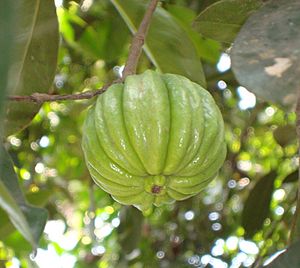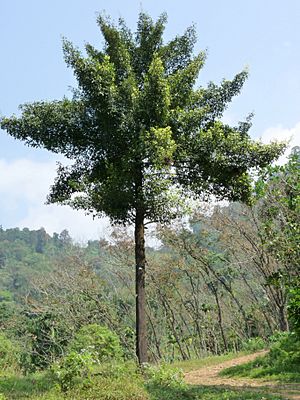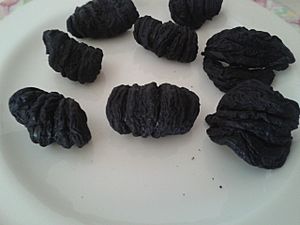Garcinia gummi-gutta facts for kids
Quick facts for kids Garcinia gummi-gutta |
|
|---|---|
 |
|
| Scientific classification | |
| Genus: |
Garcinia
|
| Species: |
gummi-gutta
|
| Synonyms | |
|
|
Garcinia gummi-gutta is a plant that grows in warm, tropical areas like South Asia and Southeast Asia. It is also known by its old scientific name, Garcinia cambogia. People also call it brindle berry or Malabar tamarind. The fruit of this plant looks a bit like a small pumpkin. It can be green or light yellow.
This fruit has been talked about a lot in the media for possibly helping with weight loss. However, studies have shown it does not really help people lose weight. Also, some people have had unpleasant side effects, like issues with their liver, when taking products made from this fruit.
Contents
Growing the Garcinia Plant

Garcinia gummi-gutta is grown for its fruit in Southeast Asia and South Asia. It belongs to a plant family called Clusiaceae. The fruit of G. gummi-gutta and similar plants can be as big as an orange or a grapefruit.
The G. gummi-gutta fruit often looks like a small pumpkin. It can be yellowish, greenish, or sometimes reddish. When the outer skin, called the rind, is dried and prepared for storage, it turns dark brown or black.
Natural Chemicals in the Fruit
The Garcinia gummi-gutta fruit contains special natural chemicals. One important chemical is called hydroxycitric acid. This acid can be taken out of the fruit and is used in some dietary supplements.
Other natural chemicals found in the fruit are polyphenols, like luteolin and kaempferol. These are plant compounds that can be good for health.
Different Names for Garcinia
In the Malabar Coast area, people call this fruit kudam puli. In parts of Sri Lanka and India where Tamil is spoken, it is known as goraka. These are local names for the same plant.
Understanding Weight Loss Claims
In late 2012, a well-known TV doctor in the United States, Dr. Oz, talked about Garcinia cambogia extract. He called it an "exciting breakthrough" for natural weight loss. When Dr. Oz talked about dietary supplements, many people would buy them.
However, scientific studies on Garcinia cambogia have not shown that it helps with weight loss. In fact, a study from 2011 found that people taking the extract had more stomach problems than those taking a placebo (a fake pill). This suggests the extract might not be safe for everyone.
Some products containing this extract have even been taken off the market. This happened because people experienced unpleasant side effects. These side effects included problems with the liver and issues with the stomach and intestines.
Possible Side Effects
Besides possible liver issues, the hydroxycitric acid in Garcinia can cause other side effects. These might include a dry mouth, feeling sick to your stomach (nausea), stomach discomfort, and headaches.
Garcinia in Cooking
Garcinia gummi-gutta is used in cooking, especially in curry dishes. It adds a sour taste to food. The dried rind of the fruit is used in many traditional recipes in Southeast Asian countries.
In Ayurvedic medicine from India, sour flavors are believed to help with digestion. The dried rind of G. gummi-gutta is a common ingredient in Indian curries. It is also a key souring ingredient in a sour curry from southern Thailand called kaeng som.
Gallery
See also
 In Spanish: Tamarindo malabar para niños
In Spanish: Tamarindo malabar para niños






